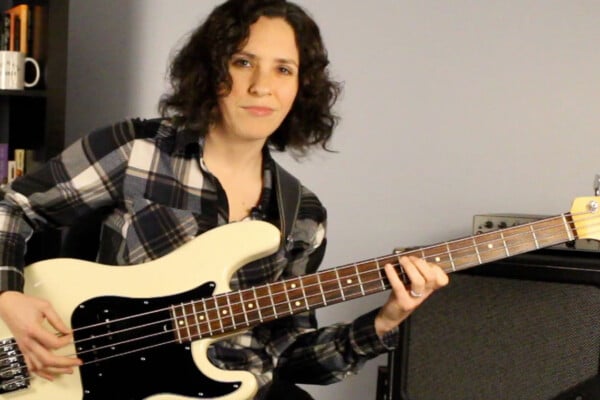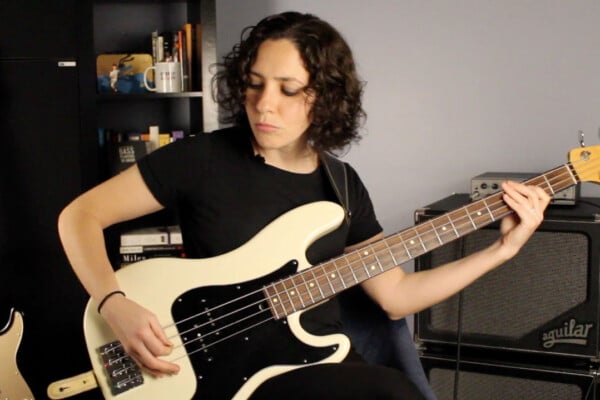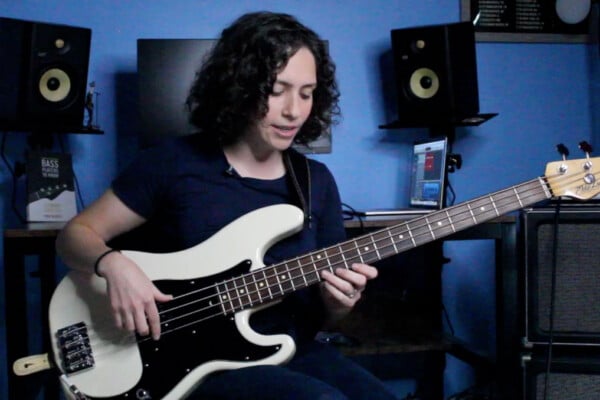Lesson: Stance on the Upright Bass
In this week’s lesson, Jon takes us through some key fundamentals in upright bass playing.
Balance
Balance is the key. It takes many pounds of pressure to hold a string against the fingerboard with enough firmness to get a good fundamental tone; this force needs to have a counterweight applied against it. The objective is to get maximum weight into the bass with minimum effort through using leverage against the body and floor or against the weight of the instrument. Squeezing between the thumb and fingers is to be avoided at all costs; flat fingers and collapsed joints are to be avoided as well. Body weight is anchored by the legs and transferred through the back and arms onto the string, with the weight pulled in toward the center of the body. The upper body can lean slightly downward to accentuate the weight passing through the arms and hands. The bass may also swing around past its vertical balance point to oppose the fingers and arm with its own weight at certain times, particularly to counterbalance the weight into the lower strings.
There is no single, static “correct” position because every note has its own requirements for address. The bass is big, every note exists in its own point in space, and the physical requirement to play each note is slightly different than every other note on the bass. This is more of an advantage than it might seem at first; every note, every location in space has its own feeling to the body; training the body to remember these feelings is the most direct way to learn how to get around and find the notes on the bass, Marking the neck or fingerboard for visual cues can be helpful in the beginning to give the student a visualization tool, but as the student progresses past the very early stages, they learn the bass by learning the feeling of playing it. We can use visual cues at first, but the sooner we are able to shift our awareness to the feeling of a particular motion we are learning, the faster learning will progress.
Equal Weight distribution
Weight should be evenly distributed between both feet, although it may shift at times from one to the other depending on the demand of the particular address; or, a regular shifting of the weight from foot to foot on the first and third beats can be a powerful aid in creating a walking bass feel. The players’ two feet and the endpin form a triangle on floor. The bout of the bass rests roughly in the center of the body, slightly above the navel. This point of contact can shift to the right to offer easier address to the lower strings. The front of the bass is generally at an angle so that the top draws a line that would touch the right big toe; this is a good starter position, but this will change depending on the balance requirements of each particular note. The bass can rotate clockwise from this original axis when its weight is used to oppose body weight and take additional pressure away from the thumb of the left hand. Generally speaking, when using this triangle form, the force pulled into the neck by the left hand is exerted against the balancing fulcrum of the shoulder of the bass against the midriff; this results in outward pressure against the endpin. When pressure is properly applied in this stance, it feels as if the endpin wants to shoot across the floor away from the body.
Bracing with the left knee
Depending on the circumstance and the shape of the bass, it might be desirable at times to brace the bass by placing the left knee against the back of the bass near the bottom back corner of the inside C bout. Leaning the weight of the bass against this brace using the endpin as a pivot can allow greater freedom of movement in the left arm, because its role in bracing the bass has been eliminated. This modification of the stance is easy to accomplish, depending on the circumstance, but it’s particularly useful for playing in the thumb position, allowing the left forearm to travel freely up the string without encountering the shoulder of the bass. Many players use the shoulder of the bass as a reference point to locate E’s, Eb’s or F’s up the G string. We recommend strenuously against this habit; one reason is that all basses are slightly different, and independence of this habit will allow a player to transfer their technique to any instrument, and thus be able to play the “loaner” basses that have become so ubiquitous for the traveling bassist. It is relatively easy to transfer one’s “mental map” of the fingerboard to a different instrument independent of these “crutch” habits. Another reason we recommend against this practice is that it literally stops large-interval shifts from the lower notes to the upper registers of the bass. The bass should be learned as a continuum—from day one.
The Weight of the Bass
As we mentioned previously, the bass’s own weight can be used to oppose the body weight transmitted through the left hand, or through the bow or fingers of the right hand. The bass can be leaned in to striking pizzicato fingers, or leaned against a traveling bow, and at the same time transfer additional oppositional weight against the left hand. This is accomplished by allowing the bass to rotate past its balance point. It balances at the vertical, but if allowed to travel to the player’s right past the vertical, it offers this additional, desirable oppositional weight.
Another very good means of creating oppositional balance during pizzicato playing, particularly playing walking lines for sustained periods of time, is to create opposition between the hands. The thumb of the right hand is hooked behind the fingerboard and actually pushes out against the pressure of the left hand; this relaxes other requirements of balance adjustment somewhat as we move around the neck creating lines, and acually helps maintain a consistency of walking feel.
Roundness
The fingers of the left hand should appear as if they are holding a pipe; there should be a “C” shape visible, as if one was gripping a highball glass with the left hand. The curve of the fingers should be acute enough to create the sense that they are pointing toward the heel of the palm of the hand. The entire stance should consist of a series of arcs; the left arm, the angle of the trunk relative to the hips should make a large, shallow “C.” The angle of the elbow should help create a feeling of roundness from the hand all the way to the hipbone. The knees should be bent; the body should be oriented so that while playing the bass, the body operates in the middle of the range of motion of all of the joints, allowing freedom of motion everywhere
Flexibility
There should be no static position. As we mentioned earlier, every note requires a slightly different angle of address and balance, so freedom of motion is the most essential characteristic of technique.
Whole-fingerboard gliss
Here’s an excellent exercise to help get a feel for the whole bass as an integrated unit, while demonstrating the flexibility of stance required:
Trace the entire length G string to the end of the fingerboard with the tip of the index finger of the left hand.
Feel all the muscles involved—focus on the feeling; keep the fingers traveling on the string while monitoring all of the physical adjustments it takes to keep them there without losing balance, or the bass falling over, or the fingers coming off the string. Don’t even try to make a sound at first, but just trace the strings as an exercise, all the way up and down, and repeat it many times. Don’t rest the arm against the bass as you go up; it will interrupt the motion; lift the elbow as you go over the shoulder to clear it.
Repeat this exercise on the D, A and E strings; notice the difference in stance and address requirements. Monitor the dynamics of the motion; get the feel of it; do it without looking, and observe how it gets easier with repetition. Do it until you can trace the string without looking at the hand. Notice how the abdominal muscles are exercised.



